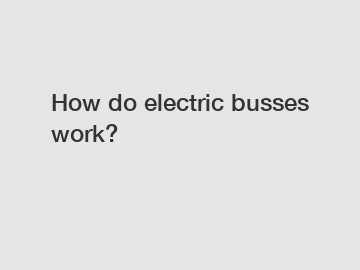Dec. 29, 2023
Hardware
How do electric buses work?
Electric buses are becoming increasingly popular as cities around the world seek to reduce their carbon footprint and improve air quality. These eco-friendly vehicles are powered by electricity instead of diesel or gasoline engines, making them an attractive alternative for public transportation. But what exactly makes them tick? How do electric buses work? In this article, we will explore the inner workings of these zero-emission vehicles and discuss their advantages and challenges.
1. Electric powertrain:

Electric buses are equipped with an electric powertrain, which includes an electric motor, power electronics, and a battery pack. The electric motor is responsible for converting electrical energy from the battery into mechanical power. This power is then used to propel the bus forward. The power electronics control the flow of electricity between the battery and the motor, ensuring efficient and smooth operation.
2. Battery technology:
The battery pack is the heart of an electric bus. It stores electrical energy and powers the electric motor. Lithium-ion batteries are commonly used in electric buses due to their high energy density, long lifespan, and fast-charging capabilities. These batteries can be recharged overnight at bus depots or through fast-charging stations strategically placed along the bus route.
3. Regenerative braking:
Electric buses utilize regenerative braking technology to recharge the battery while slowing down or coming to a stop. When the brakes are applied, the electric motor acts as a generator, converting the kinetic energy of the bus into electrical energy, which is then stored in the battery. This regenerative braking system increases energy efficiency and extends the bus's driving range.
4. Charging infrastructure:
To keep electric buses running, a robust charging infrastructure is required. Bus depots are equipped with charging stations where the buses can be charged overnight. Additionally, some cities have implemented fast-charging stations along the bus routes for rapid top-ups during the day. The charging infrastructure must be strategically planned to meet the needs of the bus fleet and ensure smooth operation.
5. Range and limitations:
One of the primary challenges for electric buses is range anxiety. Electric buses have a limited driving range compared to their fossil fuel counterparts. However, this limitation is constantly improving with advancements in battery technology. Many electric buses can now cover considerable distances on a single charge, and rapid charging technologies are being developed to reduce downtime.
6. Environmental benefits:
Electric buses offer significant environmental benefits compared to traditional buses with internal combustion engines. They produce zero tailpipe emissions, reducing air pollution and contributing to cleaner, healthier cities. By transitioning to electric buses, cities can make substantial strides towards meeting their climate goals and improving the quality of life for their residents.
7. Cost considerations:
While electric buses offer long-term cost savings through reduced fuel and maintenance costs, the initial purchase price can be higher than that of conventional buses. However, government subsidies and grants are often available to support the adoption of electric buses, making them a viable and financially attractive option for many transit agencies.
In conclusion, electric buses are powered by electricity through an efficient electric powertrain, including an electric motor, power electronics, and a battery pack. These vehicles utilize regenerative braking to recharge the battery while slowing down. Charging infrastructure is essential to keep electric buses on the road, and advancements in battery technology are continuously improving their range. The environmental benefits of electric buses are significant, reducing air pollution and contributing to a greener future. While initial costs may be higher, the long-term advantages, including lower fuel and maintenance costs, make electric buses an attractive option for cities looking to transform their public transportation systems.
If you want to learn more, please visit our website stator and rotor manufacturer, lamination in welding, lamination in welding.
If you are interested in sending in a Guest Blogger Submission,welcome to write for us!
All Comments ( 0 )